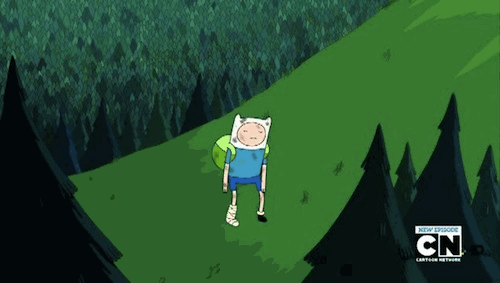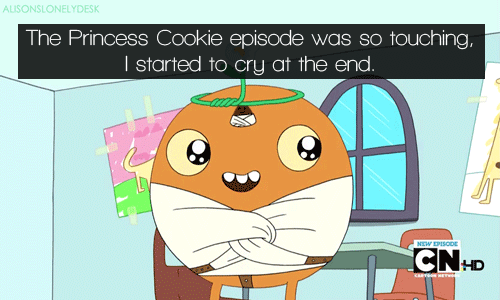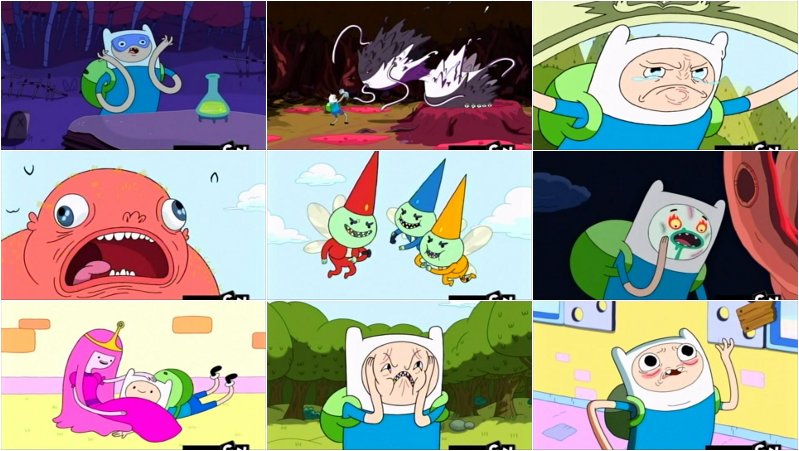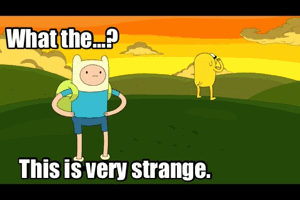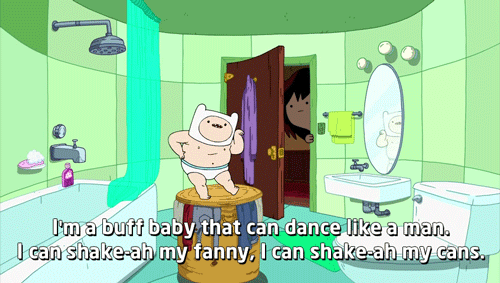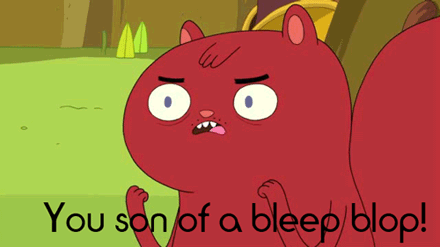Chapter 2
DISCUSSION
What are the
factors that make adults watch Adventure Time?
Reviews on
Adventure Time
The
television show, Adventure Time, has been gaining more and more popularity
since its release. It has acquired a large fan base which is composed of, not only
children, but also adults. Although the show may be a children’s cartoon, it
has expanded into something much more complicated. It has created a world
filled with such fantastic places and creatures such as: Candy people,
Rainicorns, Snow Golems, Fire Wolves, Wizards, Witches, Goblins, Gnomes, Ancient
Psychic Tandem War Elephants, and many more. Each episode, though it is not
very long, is filled with interesting stories which usually end with equally
interesting morals or even cliffhangers. A critic, Darren Franich, from the
website Entertainment Weekly said, “Episodes of Adventure Time are barely 12
minutes long. They're not all perfect, but they're never not interesting. At
its best the animated series — much like Buffy the Vampire Slayer or Watchmen —
reanimates old genre tropes and discovers fascinating new depths. Creator
Pendleton Ward has turned the series into an emotionally intricate look at
adolescence, jealousy, obsession, parental anxiety, and maturity. It's also a
fantasy panorama filled with alternate universes, penguin sidekicks, musical
interludes, and a kingdom made of candy.”
Also, when it comes to morals, they never
cease to make episodes wherein no matter how deep the moral of the story
actually is it can still be comprehended by children who watch it. An example
would be the episode Web Weirdos, which was about these two giant arachnids
that were having marriage issues. This is actually something that a lot of
adults face in a relationship, and Finn was able to help the two spiders fix
it. The writers of the show have a unique way of showing morals in their
stories, making sure that it does not wander off from the fact that it is one
of Finn and Jake’s adventures. The critic, Mike Lechevallier, from Slant
Magazine said, “Adventure Time's recurring themes and examination of morals
have also greatly evolved in its fourth season. The idea of everlasting,
all-encompassing love and its accompanying joys and hardships have always been
somewhat of a primary focus for series overseer Pendleton Ward and his creative
team, but never have the intricacies and ramifications of adoration been pushed
to the forefront of Finn and Jake's exploits as they are here.”
The characters are also a very big element
of the show. Unlike most shows, even the minor characters in Adventure Time
seem to have a deeper psychology in them than they appear, and they are able to
show this all in one episode. A critic named Joseph Leiber from the website Pop
Citizen said, “I do want to note the immense creativity and complexity that
goes into the conceptualization of the characters in Adventure Time, from the
Lemongrab of Season Three that was initially a one-off, to Goliad, to Donny the
obnoxious Jerk. They’re not just monsters, beasts or shallow characters that
merely serve to move the plot of an 11-minute ep forward. Rather, they come
pre-loaded with ethical implications, philosophical questions that will leave
you scratching your head well after the show ends, and not-so-simple
resolutions.”
The show has been making some remarkable
progress over every season. It gets deeper into its past and darker with its characters
as well. Even if the show’s main plot is about two best friends who like to
hang out with each other, it has ventured deeper into other aspects of the
show. Due to this, a lot of people have questioned on whether this show is
intended for children or not, especially since it has a lot of appeal to older
audiences. However, the creator, Pendleton Ward, stated himself that he made
the show for children. It is just that the type of humour he applies to it can
be enjoyed by both young and old. But, besides that, there must be other
reasons why adults enjoy watching it. Let us enumerate what other factors the
show has which could also appeal to these older viewers.
Factors that make adults watch
Adventure Time
A. Aging
Characters
Unlike most cartoons, the characters in
Adventure Time are not trapped in a permanent childhood. These characters
mature as the show progresses, not only by age but also through their
personality or mentality. Finn the Human, the main protagonist, was twelve
years old when the show first began. Now he has turned fourteen, and along with
that, his mind has also matured. During the early episodes of the series, his
goal in life was to be an adventurer like his adoptive parent, Jake’s dad, and
he had this idea that anything evil must be slain and that anybody with bad
intentions must be evil. However, after some adventures, he has learned to be
more understanding; that not everybody who does evil things are evil and that
someone who is evil, given the chance, can still be turned to good.
Another example is Jake’s relationship with
his girlfriend, Lady Rainicorn. In the beginning of this series, the two have
already been portrayed as lovers, and as the show progressed, we learned just
how much these two loved one another. We know that Jake would do anything to be
able to have adventures and still be able to spend time with his girlfriend,
just as we know that Lady Rainicorn would risk her life to save Jake if he was
ever in any danger. In fact, their love has even blossomed into parenthood when
Lady Rainicorn became pregnant and gave birth to five beautiful Rainicorn-puppies.
Creating the show in this way makes it
more interesting to watch, since the concept will not wear out in time. The
show’s main plot, after all, is about two friends who like to hang out. That is
a very vague idea for a series, so giving these characters lives that actually
age in time was a good idea. Now the audience watches to see how their lives
will unfold and how these characters will be as they mature.
B. Anything
is Possible
The show is filled with a diverse set of
characters and settings. It has got a plethora of princesses, each with their
own kingdoms, kings, wizards, monsters, and many more creatures that one could
imagine. Due to this, the writers of the show could never run out of ideas for
a new episode. They could think of anything to write about and it could still
make sense since, in Adventure Time, almost anything is possible.
Most episodes would start out with Finn
and Jake just strolling along, maybe even having a conversation until they
would stumble upon something which would start their adventure. Like, a talking
skeleton that’s giving away free magic powers, a witch’s garden filled with
doughnuts, a gladiator’s arena which is ruled by the Fight King, etc. In some
episodes, they would be dealing with princess-related problems, usually ones
that involve the Ice King kidnapping them. But there are also some situations
which don’t involve him, like in the episode, Jake vs. Me-Mow, Wildberry
Princess finds out that she is going to be assassinated so she asks Finn and
Jake for their help, and in the episode, Ghost Princess, Finn and Jake help
free the princess from her ghostly form and ascend to the afterlife. There are
also some episodes which would discuss the lives of certain characters and
their relationship with other characters in the show. Marceline the Vampire
Queen is a very good example for this since she has a lot of issues with a
number of people in the Land of Ooo.
The episodes that the writers come up
with don’t follow any proper plot. As mentioned, they just come up with whatever
comes to mind. Pendleton Ward stated that, the writers write for themselves, so
basically, anything goes. Although, this makes it all the more interesting to
watch since, every episode is a new adventure for Finn and Jake. It’s a new
place filled with new faces and a new experience waiting to happen. One can
only guess what they have in store for us.
C. Humour
with Cross-Audience Appeal
People have questioned whether Adventure
Time was really for kids or not, due to some of the inconspicuous jokes and
puns in the show. However, this is because the type of humour which Pendleton
Ward applies in it is one that can be enjoyed by both children and adults, or
at least that is what he tries to do. He believes that there is humour which
can be enjoyed by the young and old, and that’s what he wants Adventure Time to
be; something that not only the children can enjoy but also the adults as well.
A
great thing about the writers of the show is that they don’t restrict
themselves when coming up with jokes. They don’t stop to think about whether
children could understand it or not. They just write down whatever they think
is funny and hope that other people will find it hilarious as well. What makes
this interesting is that, most of the time, it’s the simple puns that actually
catch on. Things like using random made-up words to express their distress or
frustrations are the ones that are remembered by most viewers. You can tell
since a lot of the fans have been using some of these words ever since.
It’s not easy to accomplish something
like this, but Pendleton Ward was able to succeed this feat. Because of this
formula, he was able to attract viewers of all ages and, in turn, make
Adventure Time a success.
D. Nostalgia
Adventure Time is known to have this nostalgic
factor. In most episodes, one could relate to what Finn and Jake are
experiencing. For example, in the episode, Rainy Day Daydream, Finn and Jake
are forced to stay indoors for the day since it is raining knives, due to the
knife storm. So they decide to play a game of “lava on the floor” which is a
very nostalgic game since, a lot of children have tried playing that at least
once in their lives. Besides games, there are also other things which the
viewers can relate to, like the feelings these characters would have in certain
situations. In the episode, Who Would Win? Finn and Jake get into an argument.
Watching that episode, one could relate to the two if he had a sibling whom he
would also argue with a lot.
This nostalgic factor is accomplished due
to the fact that the writers like to write stories they would have enjoyed themselves
as a child. To put it simply, they are writing for the kid version of
themselves. It is also said that they use some of the ideas they have thought
of back when they were still children as well. With the idea of people in their
thirties writing stories based on the ideas they had during their younger
years, it is no wonder why this show can feel very nostalgic.
E. A
Dark Past
Adventure Time is set in a
post-apocalyptic world, wherein most of the inhabitants of the Land of Ooo are actually
mutants, while Finn is the only human being left. It is said that this was all
due to the Mushroom War which occurred a thousand years ago. However, there is
not a lot of information about the shows past. Pendleton Ward explained that he
doesn’t want to dwell too much into it, since war is a touchy subject in a
children’s cartoon and it would be too depressing. So instead, they make some
episodes which would show relevant scenes from the said war, however, they are
never violent and do not show anything related to guns and other war machines
at all. For example, the episode Simon and Marcy shows how Marceline and the
Ice King lived through the shambles of the destroyed city, 996 years ago. Basically,
they only show scenes from the past in order to help the viewer understand the
personality of a certain character further, like the Ice King.
Giving a children’s show something like a
dark and mysterious past is not something that all children could completely
understand. It is why adults find the show so interesting. It is filled with
these subliminal messages from the past, like the ruins you can find in the
background, and it makes one wonder what could have happened to this land. More
importantly, it makes one wonder how the two characters, Marceline and Ice
King, ended up to where they are now and how they got there, since those two
are the only ones known for living through the war.
F. Non-Stereotypical
Female Characters
A lot of the characters in Adventure Time
are female. Majority of which are princesses, but there are also others like
Marceline, Lady Rainicorn, and if you count the gender-bent episode, Fionna the
Human, Cake the Cat and Ice Queen. But unlike most cartoons, these female
characters are not like the usual stereotypes. They are more genuine and have
realistic personalities. Although in some cases they become damsels-in-distress,
there are also other cases wherein they will be given the chance to fight back.
Like in the episode, Lady and Peebles, wherein Princess Bubblegum and Lady
Rainicorn have to save Finn and Jake who were in the custody of Ricardio, the
Ice King’s evil former heart. Showing the different personalities that these
characters have and allowing them to be whatever they want to be is great,
since it also attracts more adult female viewers as well.
In terms of romance, Fionna makes a great
example and possibly a good role model since she has shown that she doesn’t
need to be in a relationship to be happy or to feel needed. She knows what she
wants and is very independent. Hopefully, girls could learn from her and
realize that relationships are not the most important things in one’s life; at
least at a young age, and that having platonic friendships with boys are all
right too.
When creating female characters,
Pendleton Ward focused on making them as normal as he made Finn. He wanted them
to have cool personalities and was trying not to make them stereotypical at
all. Because of that, an array of cute and likeable female characters was born;
Marceline being a fan favourite.
G. Morals
with a Twist
Although some episodes from Adventure
Time can get very random, they can still come up with some very heart-warming
morals. However, like most of their episode’s conclusions, even these morals
end with a twist. When Pendleton Ward adds morals to some episodes, he likes to
“flip it on its head” and make fun of it a little. So, even with these kinds of
episodes, it will still leave you thinking.
One
episode to refer to would be "Princess Cookie". It was about a cookie
who wanted to fulfill his dream to become a princess by any means necessary.
However, since he tried to use force to take Princess Bubblegum's crown by
keeping some candy people as hostages, he became a criminal. Although, Jake
realized that he was a good guy at heart and decided to help him attain this
dream. In the end, he did become a princess while he resided in a mental
asylum. The lessons there were that you should not do unlawful acts to attain
your aspirations and that it is easier to reach your goals if you have good
friends to help you. There are a lot of episodes that have these kinds of weird
endings and after you watch them, it gives you these conflicts of emotions.
There are not a lot of cartoons that can do that, making it another reason to
why this show interests so much people. One would always think that morals were
supposed to make one feel good and reflect but when he/ she watch these morals,
it will make him/ her think twice.
H. Characters
with Complicated Personalities
Unlike most cartoons, Adventure Time has
ventured deeper into its characters personalities as it progressed. Although
these characters may seem like happy and playful people, most of them actually
have very sad origins. Finn is the only human left in the Land of Ooo, and the
whereabouts of his true parents or whatever happened to them was never mentioned.
Despite this fact, he was never seen questioning this at all. Instead, we see
some moments when he just sits and contemplates on life.
Another
example is the Ice King. At first, one would label him as the antagonist.
However, there have been some episodes which have revealed that he is not
actually evil but insane. The Ice King used to be a compassionate and caring
human being named Simon Petrikov until he came across the magical crown he
wears to this day. Ever since he started to wear the crown, he began seeing and
hearing things which continued to drive him insane even if he would not wear
it. Over time, it caused his body temperature to drop, turning his skin blue,
his hair turned white as it grew, and his nose had grown long and pointy as
well. In the episode, Simon and Marcy, it showed that he was always put into
situations which would force him to wear the crown, since it also gave him the
power to control ice and snow. Due to this, he slowly began to forget about his
past life as a human each time he wore it. This is only one side of the Ice
King; his past. Today, he is a powerful being, however, because of his insanity;
he is often unaware of this. A lot of people would think of him as a pathetic
fool, mostly because he does act like one most of the time.
Giving these characters such colourful
personalities, whether they are sad or joyful ones really make the show more
interesting to watch. The psychology of these characters can affect how the
story of each episode will turn out; making the show as unpredictable as it
always is. Since psychology is a little difficult to comprehend, it must be
another reason that attracts adults to watch Adventure Time.
Negative Reviews on Adventure
Time
Although the show has gained a lot of viewership,
there are also others who are not at all keen on watching the series. These are
mostly concerned parents and possibly fans of other shows that are envious of
Adventure Time’s success. Due to this, they have also made their own reviews on
the show which feature most of its flaws. They are the following:
·
Finn
and Jake rely too much on weapons and violence in order to resolve problems.
·
There
is a mild use of gateway language such as “sucks” or “friggin”.
·
It
has this over-the-head adult kind of humour.
·
Finn
is seen without his clothes on in some episodes, like in Wizard, wherein towards
the end of the episode, everyone’s clothes get incinerated and a log covers
their crotch.
·
There
are some intense scenes like the Nightosphere which is a depiction of hell.
First of all, not every television show is
perfect, no matter how much positive reviews it receives from a lot of people.
However, it is still good to point out some of the flaws it may have in order
for the creators of the said show to be able to work on making it better.
Although Finn and Jake use violence to solve most of their problems, these
problems are usually the ones that involve defeating evil monsters and other
creatures of that sort. They don’t always use violence on the innocent.
However, for the sake of concerned parents, it is probably a good idea to put
this show in a later time slot, since it is better suited to children aged 10
years old and above.
